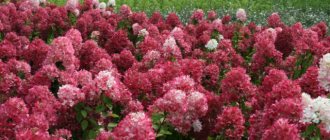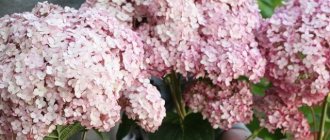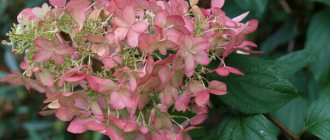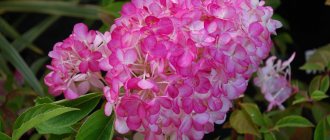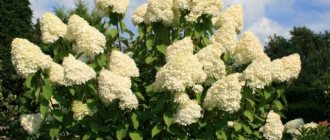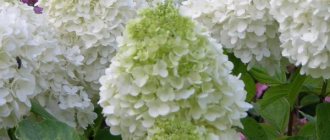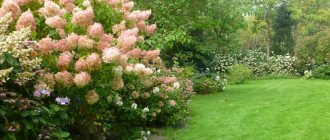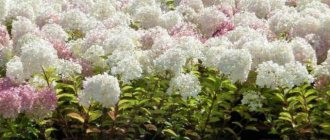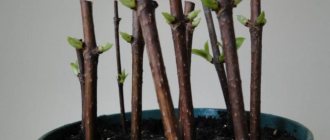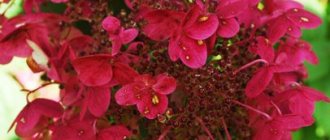One of the most attractive flowering shrubs is the Pink Diamond hydrangea. It produces large inflorescences with very beautiful flowers in white, light pink and deep pink shades. At the same time, Pink Diamond is not a particularly demanding crop. Due to its high winter hardiness, it can be grown in almost any region of Russia. Basic care requirements include regular feeding, watering and sufficient lighting.
Description of hydrangea Pink Diamond
Hydrangea paniculata Pink Diamond (literally “pink diamond”) is a fairly large, spreading shrub that grows up to 1.5-2 m in height. This is one of the most decorative varieties of hydrangea, blooming throughout the summer, from July until the end of September. The flowers are collected in very large panicle inflorescences (up to 35 cm long).
At first, the petals are painted in white and cream tones, and towards the end of summer they become bright pink. The decorative value of hydrangea is associated not only with lush inflorescences, but also with a rather dense crown. The light petals contrast well against its rich green background, giving the tree a very attractive appearance.
Pinky Diamond hydrangea flowers become especially beautiful in August and September.
Important! Pink Diamond hydrangea flowers are great for cutting as they stay fresh for a very long time.
Description of the variety Pink Diamond
Pink Diamond translated from English means “pink diamond”. Pink Diamond is classified as a paniculate type of hydrangea. The Latin name of the variety is Hydrangea Paniculata Pink Diamond. The bush begins to bloom at the age of four.
Description of the bush:
- The plant can reach two meters in height and grow almost 2–2.5 meters in width. Over the course of a year, the shoots become 20–30 cm longer.
- Straight, densely spaced branches and powerful red-brown stems form a neat, rounded crown of the bush that does not fall apart after rain.
- The shape of the leaves is ellipsoidal, finely toothed along the edges. Color - rich, dark green, matte. The texture is rough and dense. Length - about 12 cm.
- At the tops of the stems of the current year, numerous inflorescences are formed in the form of large, wide-pyramidal, densely hairy, lacy panicles, up to 30 cm long. They consist of very fragrant and honey-bearing flowers of two types. Sterile ones are larger, about 2.5 cm in diameter. At first, the color of the four petals of the flower is cream or white. Later they acquire a dark pink tint, then become almost red. Fruit flowers are small. They are painted white with a lemon tint, the petals fall early. The flowering period is long: it begins in mid-June and ends at the end of September.
- Many small seeds are formed in a fruit-box 3 mm long.
- The roots are characterized by a shallow location; the diameter of their spread significantly exceeds the size of the above-ground part of the plant.
Hydrangea Pink Diamond in landscape design
A distinctive feature of the Pink Diamond variety is lush panicles with numerous bright pink flowers. The decorative value of the bush is also associated with its beautiful, large leaves with a matte green surface. Thanks to this combination, this tree can be used to decorate the garden in a variety of ways:
- Single landings.
- Plantings near the house, along fences and other buildings.
- Several hydrangea bushes planted in a certain order, for example, in a triangle, also look beautiful.
- A lush, tall Pink Diamond hydrangea bush can be planted along the path - then it will always be pleasant to walk along it.
- Pink Diamond harmonizes well with other plants and hedges.
Use in garden landscape design
Showy, color-changing hydrangea inflorescences will enliven any landscape . The culture is used both as a tapeworm and as part of a group planting: trees and shrubs or compositions with herbaceous and evergreen plants. Select a place for hydrangea in the front garden with a diameter of up to 2 m on the north side of the site. The bush will perfectly decorate the entrance to the yard. Hydrangea among flowering and decorative deciduous bushes will create a bright colorful landscape of a landscape composition.
When placing the Pink Diamond variety in mixborders, neighboring plants with the same requirements for moisture, light and soil acidity are selected . Use combinations with hostas, astilbes, and cuffs. If the mixborder area is large, then a combination of three or more hydrangea shrubs will be successful. Their natural spreading shape creates an accent of the landscape composition in the form of unique waves that beautifully emphasize the size of the border.
Did you know? In the 18th century, the French botanist Philibert Commerson called the lush flowering shrub “hydrangea.” This word comes from the Latin "hortus"
-
garden.
The greenery of coniferous plants is a wonderful background for airy hydrangea caps of various tones . A spectacular group is a combination of hydrangea and plants with red leaves. The variety is used for landscaping city parks, squares, streets, courtyards near multi-storey buildings, and creating expressive hedges.
A combination of Pink Diamond and other varieties of paniculate pink hydrangeas will look impressive. The creamy white inflorescences of the Kyushu variety perfectly complement the Pink Diamond hydrangea in a beautiful, airy composition.
Winter hardiness of hydrangea Pink Diamond
This is one of the most winter-hardy varieties of hydrangeas, which are successfully grown not only in the central zone, but also in other regions of Russia:
- North and North-West;
- Ural;
- Siberia;
- Far East.
There is evidence that Pink Diamond hydrangea can withstand even extreme frosts down to -35 degrees. Therefore, adult bushes do not need to be covered - just mulch the roots with pine needles, sawdust and other natural materials.
Important! It is advisable to not only mulch young, recently rooted seedlings, but also cover them with burlap, agrofibre, and film. This is especially true for regions with frosty winters.
Planting and caring for Hydrangea paniculata Pink Diamond
For planting in open ground, seedlings at least 3 years old are used. The optimal planting time is spring (April, after the snow melts). At the same time, planting Hydrangea paniculata Pink Diamond is allowed in the fall, but only in the southern regions (Stavropol, Kuban, North Caucasus).
Selection and preparation of a landing site
When choosing a landing site, you should pay attention to several practical recommendations:
- Hydrangea Pink Diamond, like representatives of other varieties, loves illuminated places, but too much light will also be harmful. Therefore, it is better to choose a place with slight shade from buildings, trees or shrubs.
- In the south, the shadow may be somewhat stronger - for example, you can simply plant hydrangea next to a high fence or house. In the north, you can choose an open or slightly shaded place.
- At the same time, Pink Diamond does not like strong winds, so it needs a natural barrier in the form of bushes or buildings.
- Any varieties of hydrangeas, including Pink Diamond, prefer fertile, moderately acidified soil. However, they grow poorly in neutral soil and do not tolerate alkaline soil at all.
Advice! The acidity/alkalinity of the soil can be determined using a special solution, which is sold in stores for summer residents. If the soil turns out to be alkaline or neutral, it is better to acidify it with sawdust, fresh manure, pine needles, citric acid (a teaspoon per 10 liters of water) or 9% vinegar (100 ml per 10 liters of water) is also suitable.
The garden plot does not require any special preparation - just clean it, dig up the soil and form a small planting hole
Landing rules
Hydrangea Pink Diamond grows well on black soil and light loam. But even if the soil is not very fertile, it will be possible to grow this plant provided that fertilizers are applied in a timely manner. Before planting, you need to prepare the soil mixture. It is believed that the optimal composition for hydrangeas is:
- leaf soil (2 parts);
- humus (2 parts);
- peat (1 part);
- sand (1 part).
Another option:
- leaf soil (4 parts);
- turf land (2 parts);
- sand (1 part).
Planting is carried out according to the standard method:
- Dig a small hole with the same diameter and depth (30 cm).
- Water with 2-3 buckets of water.
- Cover with soil.
- Place the seedling in the center so that the root collar remains on the surface of the ground.
- Water again.
- Mulch with pine needles, sawdust and leaves (layer 6-7 cm).
The Pink Diamond bush grows quite widely, so when planting several hydrangeas, it is necessary to maintain an interval of at least 1 m
Watering and fertilizing
Any varieties of hydrangeas, including Pink Diamond, love abundant (but at the same time moderate) watering. Therefore, it is necessary to follow a certain regime:
- If precipitation is heavy, there is no need to water the plant - you can pour 1-2 buckets only once a month, as needed.
- If there is little rain, it is necessary to water weekly with 2-3 buckets so that the soil remains slightly moist all days.
- In case of drought, watering is increased to 2 times a week. But as soon as the rains begin, it must be stopped - excess moisture harms hydrangeas.
This variety is also quite demanding when it comes to fertilizing, which is applied several times a season (about once a month) according to the following scheme:
- In the spring, nitrogen fertilizers are applied - this can be saltpeter or organic fertilizers (infusion of mullein or bird droppings).
- In summer, potassium and phosphorus fertilizers are added 2-3 times (monthly). They begin to be introduced from the budding stage.
- At the end of August, you should stop fertilizing so that the bush can calmly prepare for winter.
Advice! To increase the strength of the branches, young seedlings can be watered periodically (2-3 times a month) with a weak (1-2%) solution of potassium permanganate.
Pruning Pink Diamond hydrangea
Pruning Pink Diamond, like most other varieties, is mandatory. Thanks to this, the crown retains its attractive appearance. In addition, removing old branches promotes more luxuriant flowering, since the bulk of the nutrients goes to young, healthy branches.
The bush is trimmed regularly. The main pruning is in spring (it is carried out in March, even before the sap begins to flow). Using pruning shears or garden shears, remove:
- dead, old shoots;
- damaged branches;
- branches protruding strongly beyond the crown.
It is also worth periodically thinning the crown, cutting off all branches growing inward, and not on the sides. Young shoots are pruned so that 2-3 buds remain. You can repeat the haircut in the fall, shortly before the first frost.
Preparing for winter
Since Pink Diamond hydrangea is a winter-hardy variety, it does not need special shelter for the winter. However, it is better to cover young seedlings with soil and mulch the roots. To do this, create a layer of pine needles, sawdust, fallen leaves to a height of no more than 6-7 cm. In the future, this procedure is optional
However, it is better to carry out mulching at the beginning of each season. This is especially important for arid regions, because a layer of mulch protects the soil from drying out quickly.
Important! In regions with a harsh climate, prolonged frosts below -30 degrees lead to the complete death of young shoots. Therefore, it is better to remove them every spring. To prevent this phenomenon, you can cover the bush with burlap or other materials.
Growing and care
The beauty with pink inflorescences belongs to light-loving crops. You can also place it in partial shade. It is better to protect hydrangea from direct sunlight, otherwise the delicate flower petals will become burnt and lose their brightness. Drafts will also not do Pink Diamond any favors.
Pink Diamond prefers loose, moderately moist soil with a high humus content and an acidic reaction. You should not plant this variety in soil rich in limestone - with such a substrate you will not get a decorative appearance from the plant. You can use specialized soil for planting, or make up a soil mixture yourself from 2 parts peat, the same amount of humus, 1 part leaf soil and 1 part sand.
The plant should be planted away from large shrubs and trees so that they do not have the opportunity to take away the moisture from your pet, for which it is very generous. It is worth maintaining a distance of 1 meter between crops, taking into account the width to which the bush grows. The planting hole is dug to a depth of 30 cm. It must contain a layer of drainage material. The root collar of the plant does not need to be buried. After planting, the hydrangea is watered, and after a while the soil under the flower is loosened. Afterwards, the tree trunk circle is mulched. For this procedure, sawdust or pine needles are used, which also acidifies the soil.
Watering Pink Diamond should be regular. The soil under the crop should not be allowed to dry out. Up to 30 liters of water are poured under one adult bush, which must first be allowed to brew to soften and warm up a little in the sun. Frequency of moistening the soil under the flower: 1-2 times a week, depending on weather conditions.
Fertilizing also needs to be given great attention. In spring and early summer, hydrangea needs nitrogen. The shrub can get it from organic fertilizers, for example, slurry. During the same period, complete fertilizer with microelements must be added to the soil. All this is necessary to stimulate growth and the appearance of green mass on Pink diamond. When the buds begin to form, treat the beauty with superphosphate and potassium sulfate. Repeat this feeding twice more until the end of summer. It will not be superfluous to provide mineral nutrition to the plant in the fall, in order to create conditions for successful wintering.
Be sure to include pruning in your Pink Diamond care plan. In the spring, it consists of removing broken and diseased shoots, shortening healthy and strong stems to 3-5 buds on each. Autumn pruning affects dried out old inflorescences.
The shrub does not need to be covered if the winters in your region are mild and warm. In the case of severe frosts and, especially, minimal snow cover, it is better to insulate the crop in the fall. This is not difficult to do: the shoots need to be bent to the ground and sprinkled with fallen leaves or straw. First of all, this should be done with young specimens, because the level of winter hardiness of hydrangea increases with age.
The plant may be attacked by pests such as aphids or contract powdery mildew. For preventive purposes, the culture should be treated with drugs such as Vitaxid or Oxychoma. A folk remedy, a soap-garlic solution, has also proven itself well.
Propagation of Pink Diamond hydrangea
Hydrangea is bred in different ways:
- cuttings;
- layering;
- seeds.
The easiest way is to obtain layering. The algorithm of actions is as follows:
- In mid-spring, the lower shoot is fixed on slightly loosened soil and sprinkled so that only the top remains on the surface.
- Water regularly and make sure that the green part grows quickly.
- In September, the roots of the cutting will be fully formed - it can be separated from the mother bush.
- Then the cuttings are planted separately and prepared for wintering (mulching, covering).
- Next spring they need to be planted in permanent places.
Propagation of hydrangea by cuttings is also quite simple - green cuttings are obtained from apical shoots in early summer. First, they are rooted in the sand, and after 2-3 months they are transplanted into containers with ordinary fertile soil. The cuttings overwinter indoors and in the spring they are transferred to open ground.
To obtain a hydrangea cutting, it is enough to cut off the apical shoot with 2-3 pairs of leaves: the lower pair is removed, and the rest are cut in half
Diseases and pests
In general, the Pink Diamond variety is resistant to unfavorable climatic conditions and diseases. But from time to time it can be affected by various pathologies:
- gray rot;
- powdery mildew;
- leaf spot;
- root rot;
- chlorosis.
In the case of fungal diseases, it is necessary to treat with fungicides. If diseases are associated with improper care (yellowing of leaves due to chlorosis), nitrogen fertilizers must be applied. A solution of citric acid (5 g) and iron sulfate (3 g) per 1 liter of water is suitable.
Hydrangea chlorosis can be associated both with insufficient feeding and with the spread of infection.
Pink Diamond, like other varieties of hydrangeas, is susceptible to insect pests, for example: aphids, spider mites, leaf rollers. In the fight against them, insecticides and folk remedies are used (mustard infusion, decoction of marigold flowers, soda solution, laundry soap and others).
